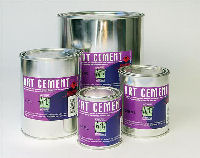|
A few warnings before I get into this guide: 1. Under new ITTF rules,
the VOC based glues are now illegal to be used for ITTF events, and most
national associations and clubs have adopted the same rules, and testing for
these substances may be done at some events. Although "airing" the bat after
you've glued it up for a few days may well cause all the VOC to evaporate, there
is still a risk your bat may be found to be illegal
2. ALL the VOC based table tennis glues contain dangerous and poisonous
compounds, so contact with the glue or breathing in the vapours is a health
hazard. However these glues have been used for several decades by players
worldwide, so when handled with care in a well ventilated area, the risk is
actually quite low.
VOC based glues and the ITTF Ban:
Since the ban of all VOC based table tennis glues by the ITTF, most
manufacturers have stopped producing them. The ban was really focussed on VOC
based "Speed Glue" (that most top players use), as these produce a lot more
vapours, and therefore pose a much greater health risk. However since the ban,
and the subsequent testing for VOCs to identify their presence, cannot
distinguish between speed glue and normal glue, both glues are effectively
banned.
Although there are quite a wide range of water based glues around, I don't
feel they are as easily used, nor are they as quick to use or as effective. The
VOC based glue actually gave rubbers a mild form of priming, which actually
boost their performance a little, although not everyone find this effect
noticable. This effect is more noticable (and effective) on hard sponged Chinese
rubbers than it is on most Euro/Japanese rubbers. Water based glues are also
currently more expensive, although this is more likely because they are a new
product, and the prices are likely to settle down over time.
Some rubber do have warning on them, and recommend to ONLY used water based
glue. I've glued many of these rubber with VOC based glues as have some of my
friends and fellow player, and have never had a issue with them.. Only speed
glue is likely to be an issue, as it stretches the rubber quite a bit. Still if
you're worried about voiding the warrantee of a rubber, or are very worried
about damaging the rubber, or the health issue is an concern, then you might be
better off with water based glue.
Making your own VOC based glue:
The basic ingredient of VOC based table tennis glue is rubber cement.
Although there were variations in the glues from the different manufacturers,
there was really not a great deal of difference between them. Rubber cement, not
to be confused with contact cement, is most commonly available at art supply
stores, as it's still commonly used in this area.
A similar product, called vulcanising fluid or cement, is also still commonly
used in the rubber/tyre industry, and you can even find it in bicycle repair
kits. However I believe this is more nasty with some more highly toxic
ingredients, so I would recommend the stuff from the art supply stores. Note
though that both are highly flammable, dangerous and toxic, and I have no real
basis for my preference for the art cement. You can find some more details on
rubber cement from the wikipedia here:
Rubber
Cement. Below are a few pictures of rubber cement tins, I
personally use the National Material Art Cement (NAM) on the left. The brands
"Best Test" or "Elmers" are more common in the US.
 
So you can call or visit your local art supply store and buy the art cement
in small to large tins... usually varying from 100ml to 4000ml. All the stores
I've seen also sell a thinner for the rubber cement, which is basically an
organic solvent meant to thin down the glue. Usually the rubbers IS a little
thicker than regular table tennis glue, so thinning it down is recommended, as a
glue too thick can form too strong a bond between your rubber and blade, making
it hard to remove.
Although solvents like Paint Thinner or Toluene may do
the job too, I believe they are a lot more nasty so I would not recommend them.
In a well ventilated area, you can thin the rubber cement down, by
pouring some into a smaller tin, and mix roughly 10xrubber cement with 1x
thinner. You can try less thinner first, since some glues may already be
thinner, but with all the ones I've tried the 10:1 ratio works well. After you
put them together, mix them well with a stirrer, like a screwdriver or something
else that is not affected by the glue, and from which it's easily removable
afterwards. Mix well for a few minutes, until the mixture looks consistent with
no lumps or thick bits in there.
At this point the glue is ready to used immediately. I usually pour it into
an old glue or speed glue tin, one that has a brush attached to the lid, since a
brush makes it real easy to apply and spread the glue.
I will personally continue using it for most jobs that I do, as I feel it
does a better job and I do take all the necessary precaution to make sure it's
not health issue. The only time I used the water based glue is when people
request it, or if I know the bat will be used in a tournament where testing for
VOCs may be performed.
Hope you find this guide useful... if you have any comment, please Email me
using the contact button at the top right of the page... |